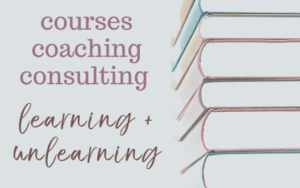Over the past year, my body has experienced a few physical injuries, including a concussion from falling last January and a cut from stepping on a broken bowl back in August. The fall left both knees badly scraped and bruised so that scars are still visible on the surface.
The puncture in my foot has involved months of getting ceramic out—piece by piece—and an MRI now confirms that “only scar tissue remains.” That scar tissue isn’t visible like the scars on my knees, but it’s vocal in its insistence to be heard and healed. Too often, I trace its contours and cry out when hitting it just so. Now that I’ve started physical therapy, I feel new sensations (sometimes sharp, sometimes subtle) when strengthening, stretching, and shifting body tissues.
Both of these scars—on my knees and in my foot—have me thinking about what it means to be “scarred.” I realize that scarred is only one letter off scared, perhaps signaling remnants or reminders of fear within the body?
Fear shows up for me in all sorts of ways. Looking back, I realize that I’ve written in the past year about befriending (rather than fearing) spiders, about how Alice Walker helps me think about the links between fear and dehumanization, and about why I so value and embrace the mantra “do it scared.”
Right now, what I’m doing scared is looking at my scars and learning to love (rather than fear or regret) them.
I’m loving these scars:
- for the stories they hold and the lessons they continue to teach
- for the invitation to rethink beauty and imperfection and to see how they coexist and feed into each other
- for reminders of my body’s remarkable ability to recover and renew itself
- for what I learn from experiencing and witnessing change over time.
For too long, whenever I’ve hurt myself, I’ve been quick to feel regret and to express self-criticism like:
- “Ah, I should have been walking more mindfully.”
- “I should have listened to my desire for rest; then I wouldn’t have been rushing.”
- “I should have cleaned the floor better after I dropped the bowl. How did I leave such a large shard for me to step on?”
These shoulds lead into a deep, dark tunnel that easily spirals into the stuck place of guilt, immobilizing self-love that’s needed for the healing process. The more I tap into and learn about the energy of regret, the more I understand why white guilt is often described as a place of immobilization, of shutting-down, of preventing reflective self-work. It’s only when I understand guilt by recognizing, allowing, investigating, and not judging (that is, by using the RAIN method) that I open to compassion and do the self-work aligned with healing.
As I study the scars on my body, I’m coming to appreciate them more and more. I only get there through remembering the initial pain and hurt as well as the embarrassment and shame that arose around these injuries. I only appreciate these scars by making space for the grief that accompanies them, as I remember, for example, how my foot used to stretch without aching. Likely it will again, if my history with back pain is any indication. But to make way for the new, I must release the old, including old expectations, old embodied habits, and old emotional patterns.
In this moment—to make way for the new, to heal our individual and collective bodies, to envision a more just world, and to strive for the “ought to be”—we need to reckon with our scars. Collectively, our bodies are scarred (and scared). The land is scarred. Institutions are scarred. Relations are scarred. And more …

What will it take to remember, resist, redeem, and reconcile our collective scars (to use the four themes of America’s Black Holocaust Museum)?
How can we learn to recognize scars rather than denying or dis-allowing everyday pain?
How might naming scars as scars allow for movement from a stuck-place of guilt to mobilization toward action?
Like my physical therapy to break up and mend scar tissue, answers to such questions involve ongoing commitment to digging in and doing the work. Moment by moment, day by day, week by week. May we not delay in responding, but instead engage in the process of learning from and healing scars, both personal and collective.
—
This post is written by Beth Godbee for Heart-Head-Hands.com. For more posts like this one, you might try “Attending to Anger” and “Today Healing Looks Like …”
If you appreciate this site, if you connect with the storytelling, or if you use any of the recipes or resources, consider making a one-time or sustaining donation. Please also consider subscribing to posts and liking this blog on FB. Thanks!
*****
Interested in listening to this blog post?
Check out my SoundCloud account, and subscribe for new audio content.





Leave a Reply